Ben Thanh Market is somewhere you absolutely have to visit in Ho Chi Minh City. See locals buying their produce for the week, stall vendors enthusiastically selling you anything and everything, and tourists shopping up a storm.
It’s the perfect place for someone who loves to shop and get a bargain (me especially). Bartering is the norm here which can feel a little strange and daunting if you’ve never done so before. We’ve got some insider tips on how to barter and how to not get ripped off.
We’ll also have you covered on EVERYTHING there is to know about the market – from the history to a Ben Thanh price guide and most importantly what to buy at Ben Thanh Market.
If you’re short on time, consider checking out this market tour and cooking class. You’ll get an authentic view of the market (before the tourist crowds rush in), plus you’ll learn how to cook some of your favourite Vietnamese dishes.
Read on to find out everything you need to know about Ben Thanh market!
Follow us on Instagram!
History of Ben Thanh Market
Ben Thanh Market has been around for over 100 years through important times of Vietnam’s history, including the Vietnam war. Believe it or not, there are thousands of stalls packed into the building with tens of thousands of visitors daily.
Before the arrival of the French, Ho Chi Minh City (known as Saigon at the time) was a fishing town teeming with traders along the Saigon River. The original floating markets occupied the Saigon River. The surrounding canals offered the convenience for smaller boats to pick up and drop off items for trade.
Unfortunately, the market burned down in 1870 which lead to the construction of the building used today. The name Ben Thanh actually derives from the words harbour (Ben) and Citadel (Thanh).
Since the building was constructed around the time of the French Colonial Era, the building holds strong French influence. The southern gate of at Le Lai Street features the clock tower.
Nowadays, the market has become the most popular market in the whole of the country. Its existence contributes largely to Vietnam’s economy.
Ben Thanh Market Opening Hours and Location
Ben Thanh Market is located at the intersection of Le Loi, Ham Nghi, Tran Hung Dao and Le Lai Streets, right in the middle of District 1 in Ho Chi Minh City. If you’re close (around 500m away) and aren’t 100% sure where to go, follow the mass of tourists working towards the market. It should be easy, but here is its location on Google Maps. Make sure you pick up a Viettel sim card when you arrive to help you find your way around (you can read more about sim cards in Vietnam here).
There are both day and night markets to attend. The day market runs from 6am – 6pm and the night market runs from 6pm – 10pm. It runs for 16 hours a day which makes it convenient to attend.
During the early evening, shop vendors tend to close as the restaurants and cafes around the markets come to life.
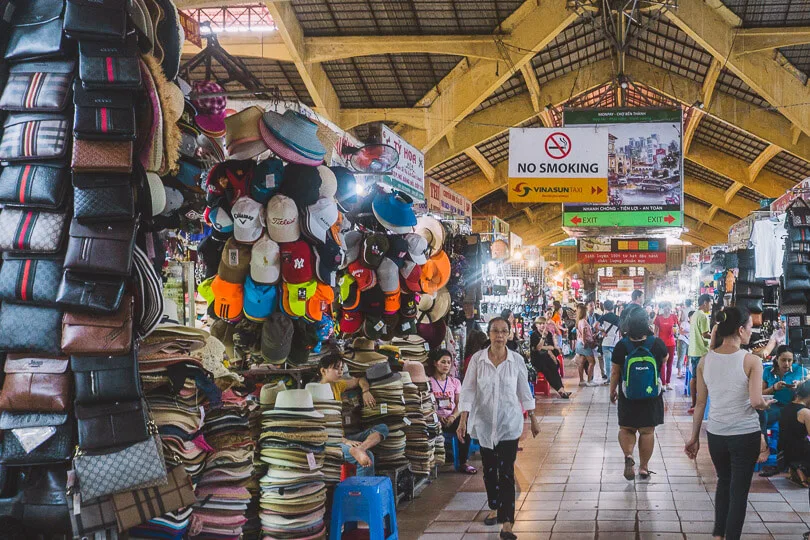
Getting to Ben Thanh Market
The chances are if you’re staying in Ho Chi Minh City, you’ll be staying on or near Backpacker Street, Pham Ngu Lau. Getting to Ben Thanh Market is simple from there, it’s just an 8-minute walk.
If you’re staying somewhere too far to walk, Grab is your best bet. Grab is the Uber of Southeast Asia, and in Vietnam, it is super cheap! A 10-minute drive will only cost you about 35k VND, or $1.5 USD. People often opt for Grab motorbikes, but we personally like to escape the heat and enjoy the comfort of an air-conditioned car.
If you’re coming from the international airport, Grab is still a great option at around 160k VND. Otherwise, Bus 152 will take you straight to the market for only 15k VND.
Ben Thanh Market Map & Layout
Ben Thanh Market is a major tourist attraction so it can get very busy. If you’re not so into shopping or crowds, it’s still a must-do in Ho Chi Minh City. Instead, go early in the morning to beat the crowds. Generally the earlier you go, the less busy it is.
The market is huge (the shops span 13,000 m²) so you’ll be surprised how long it takes you to weave through the aisles. Give yourself at least an hour – more if you’re looking for souvenirs or are wanting to shop for yourself.
There are four gates to the market, located at each surrounding street. If you don’t come through the Southern gate on Le Lai Street, check it out. It’s the side of the building with the famous clock tower.

If there’s one thing to take away from this article – don’t buy the first item you see. Just window shop and scope out the prices as you’re guaranteed to find one, two or ten other stores within the market selling the same item.
The outer ring of the market tends to have fixed priced items. This is a great place to browse prices or to buy items if you’re not so comfortable with bartering.
Fake luxury and sporting brands especially are everywhere in Vietnam, not just Ben Thanh or Ho Chi Minh City. Don’t be too eager to make a purchase unless you know what you should pay for the item or are comfortable haggling.
Tips for First-Time Visitors
Bartering
Funnily enough, I was given the nickname ‘barter gremlin’ from my friends when I was in Vietnam. I’m not sure if it was my competitiveness or love for shopping and bargains (probably a combination), but I seem to have the knack for landing a great deal.
The general rule of thumb is to pay around 40% of the original offer, so start bargaining lower than that and take it from there.
10k VND equals around $0.43 USD, so there’s no point wasting your holiday bartering over small amounts. After all, 10k VND may mean a lot to the locals, but not to you.
Learning a little Vietnam helps to communicate with the locals and build a connection. Before visiting, I learned to say Đắt quá (pronounced dah kwah), meaning too expensive. I’d usually say this after their first offer which usually followed with a smile or laugh from the vendor and a great counter offer.

Here are some simple phrases that will help you when shopping:
| English | Vietnamese |
| Hello | Xin chào |
| Thank you | Cảm ơn |
| Please | Xin vui lòng |
| Yes | Vâng |
| No | Không |
| How much is it? | Bao nhiêu tiền? |
| Too expensive | Đắt quá |
| Do you speak English? | Bạn có nói tiếng Anh không? |
I’ve also heard vendors tend to offer the best prices in the mornings to give them good luck for the day. I personally haven’t noticed much of a difference though, especially if you’re willing to bargain.
Crowds
Ho Chi Minh City is the largest city in Vietnam, with a population of over 8 million. Although Vietnam has only become a tourist destination in the past 20 years, it has become increasingly popular in recent years. Because of this, the city does get very crowded, especially in tourist areas.
Ben Thanh is one of the areas that gets absolutely packed at times. Pair this with vendors eagerly trying to sell you their goods and figuring out how to haggle – this can be quite overwhelming.
For these reasons, Ben Thanh Market isn’t the best market for your first visit. This is especially true as vendors are known to take advantage of this being a tourist destination, and inflate their prices as much as 300-400% compared to other markets.
We’d recommend you start out at a smaller market where you’ll find more locals. Tan Dinh Market is our favourite. Also located in District 1 at 48 Hai Ba Trung Street, Tan Dinh, this is a great place to start at. It’s less than a 10-minute drive away from Backpacker street and only costs about 35k VND to Grab there.
Some places within the market do fixed prices and in our experience, prices aren’t nearly as inflated as they are at other areas. You do still have to do a bit of bartering here, but it’s a good place to start.
If you have been to a Southeast Asian country before or feel comfortable jumping straight into bartering, then you should be more than fine to start at Ben Thanh.
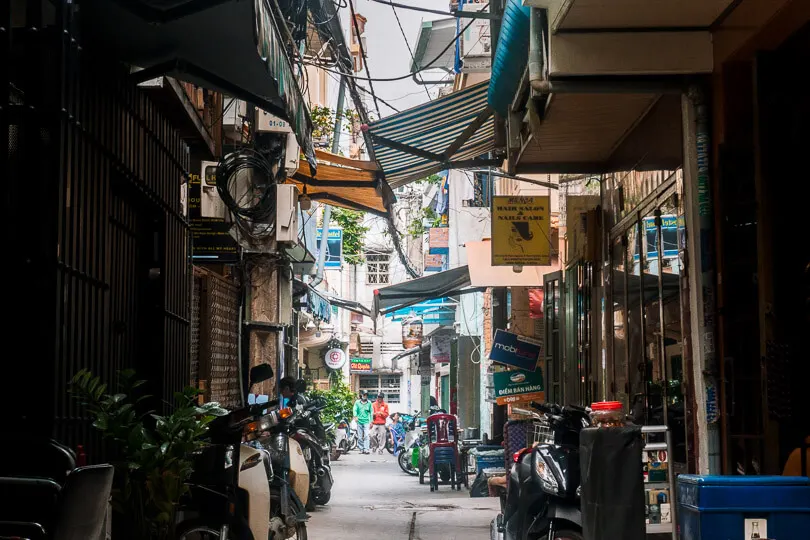
Security
Ho Chi Minh City is notorious for petty crimes such as pick-pocketing. I have a friend who had her handbag snatched by a passing motorcyclist. Thankfully, she escaped unscathed (with her handbag and only a couple of scratches), but this does illustrate how petty crimes do happen from time to time, especially in crowded areas such as the Ben Thanh Market.
These travel-savvy tips are worth a read.
Avoid wearing flashy, large items of jewellery that would put a target on your back – especially necklaces that could easily be pulled off you.
If you have to bring a handbag and you’re walking on the sidewalk, make sure your bag is on the side of your body facing the shops, not the road. This makes it easier to snatch.
When carrying a backpack, try carrying it across your front or keep a lock on it. This TSA Lock Set is a great and affordable option. You could also look into opting for a bag that doesn’t allow for easy access i.e. drawstring on the inside and buckles on the outside.
Last but not least, keep money in various locations on your person. I used this Eagle Creek Bra Pouch to keep my ID, a small amount of ‘emergency cash’ and Eftpos card which I also only kept for emergencies as many places in Vietnam operate a ‘cash only’ policy.
I also kept a small pocket safety-pinned on the inside of my shorts. I kept the majority of my money here as it was easy to access.
Then I also kept a wallet with extra cash at the bottom of my backpack, hidden under various items like a travel towel, hat and drink bottle. I carried my backpack on my front most of the time, but if somehow someone did get into my backpack without me knowing, they’d have to go through my whole bag to get to my wallet – which seems quite unlikely.
We spent a few weeks in Vietnam and never had any problems with security. I’m only 5 feet so I was a little nervous I’d appear as an easy target but all in all, the vast majority of locals are super friendly and welcoming. As long as you follow these tips and make sure you’re observant at all times, you should be fine.
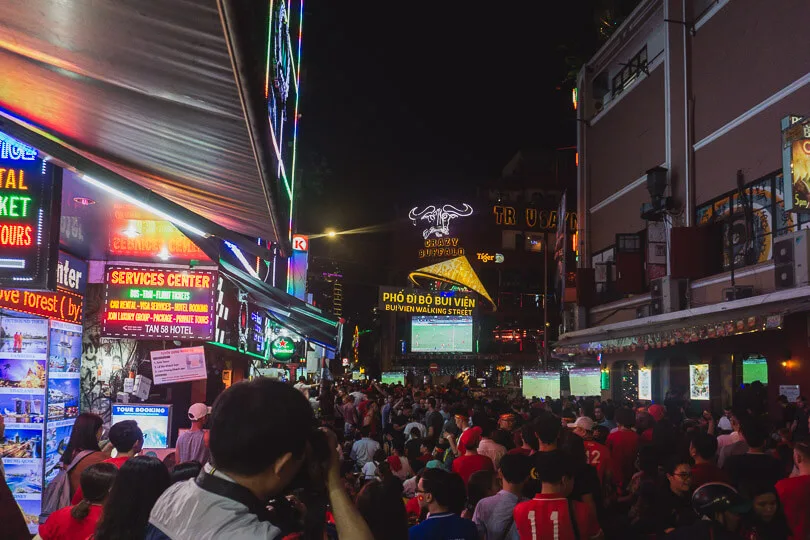
What to Buy at Ben Thanh Market
You can buy anything and everything at this market. We’ve included a Ben Thanh Market price guide for all items – this is what we’d consider good prices at this market. You can use them as a guide for bartering when visiting.
We’ve also put together a guide to the best things to buy in Vietnam, so make sure to check it out for some more ideas!
T-shirts
Price: 100-160k VND
- 100k VND for unbranded t-shirts with printed slogans
- 120k VND for sportswear i.e. Nike
- 160k VND for fake luxury brands i.e. Gucci
Not just Ben Thanh, but t-shirts are definitely the most popular item to buy at every Vietnamese market.
You’ll find an array of designs, from block-coloured t-shirts with a witty slogan or joke, to fake branded t-shirts. I guarantee you’ll see a vendor selling Gucci t-shirts at every turn.
Asian sizing is typically smaller compared to the rest of the world, but Ben Thanh is an incredibly popular tourist market so they cater to Westerners. You’re likely to find your size of clothing at Ben Thahn Market.
Sportswear
Price:
- 120k VND for a t-shirt
- 100k VND for shorts
- 900k+ VND for shoes
You’ll find all types of sportswear at Ben Thanh Market. Most items include fake brands such as Nike, Adidas and Under Armour.
For t-shirts, the quality didn’t seem to be on par with authentic items, however, the price was too good to pass up. Once again, it seems to be the shoes that appear as the best quality replicas.
To have more room in your suitcase for shopping, you could consider not bringing sportswear with you, then buying some in Vietnam.
Elephant print pants
Price: 80-100k VND
I cannot stress how comfortable these are to wear especially in hot climates.
Let’s face it, you’re probably not going to wear these pants when you return home. Since they’re so cheap and take up very little space in your suitcase, they’re worth buying just to wear and be comfortable during your holiday.
They come with both elasticated waist and ankles. This comes really handy when finding your size as they will stretch to accommodate many body types. Plus, the elasticated ankles mean you can pull them up to your knees to create ¾ pants for when it’s really hot.
For women travelling to conservative countries where you need to cover your knees (i.e. to visit temples), then these are a great option to carry around in your backpack. Just pop them over your shorts before you enter a temple.
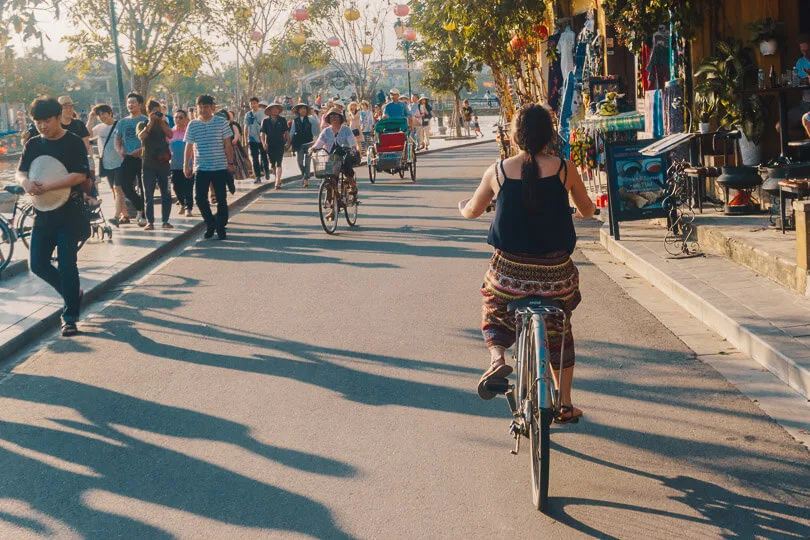
Fake luxury items
Price: This can vary greatly. T-shirts will only cost you 160k whereas shoes may cost you much more. Aim to pay around 40% of the first offer.
You’ll find every luxury brand you’ve ever heard of. Think Balenciaga, Fendi, Gucci, Versace and more. Apart from t-shirts, the next most popular items are shoes, belts and wallets.
Check out the quality before buying as they can vary from store to store. For some items, the resemblance is uncanny. Shoes tend to be the best option and you’ll save a fortune buying them at Ben Thanh.
Ao Dai
Price: 250-500k VND
The traditional female costume of Vietnam is called the Ao Dai. Loose, flowy pants are tastefully paired with a long, fitted dress. The dress is long-sleeved with side slits from the hips to the floor to show the pants.
Have fun picking out fabric to match the pants with the dress, or buy a few and mix and match.
Bear in mind the quality of the Ao Dai at markets won’t measure up to those at a proper fabric or traditional dress store. BUT, they will definitely be a lot more affordable at as little as a quarter of the price.
Silk
Price: 120k+ VND per metre
Buy silk in Vietnam to get a custom-made Ao Dai or bring some home and get creative. If you’re looking for custom-made outfits and you find some silk you like, buy the material and bring it to one of the many tailors around Vietnam.
I’m no expert, but the quality of the silk at the market does seem adequate. If you’re looking for high-quality silk, it may be best to skip the markets and find a highly-rated fabric shop in Hoi An, the town known for tailoring and beautiful fabrics.
Vietnamese coffee and filter
Price: 100k+ VND for coffee and a filter
- Coffee: 60-120k VND per 500g bag. The price depends on the coffee grade.
- Phin filter: 40-60k VND
One of the first things you should do when you visit Vietnam is grab a Vietnamese iced coffee. Vietnamese coffee uses Robusta beans rather than the classic Arabica. The Vietnamese use condensed milk to counter the bitterness of the coffee – the combination is absolutely amazing.
Opt for either a ceramic filter or metal phin filter. We prefer ceramic and brought one home, but if suitcase weight is an issue, the phin filter’s weight is minimal.
This is a perfect gift for someone who loves coffee. Bring back a bag of coffee and a phin filter for the coffee lover in your life.
If you get hooked on this product and want to continue drinking this type of coffee at home, we have some great news for you! You can buy these beans online – we have been doing this to treat both our post-holiday blues and Vietnamese coffee withdrawals.
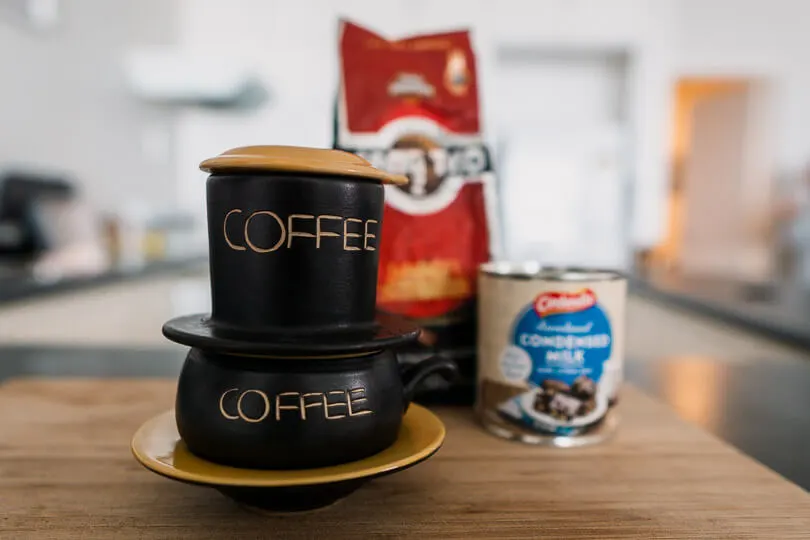
Lacquerwares
Price: 100k – 300k VND
Vietnam is well-known for its lacquerware souvenirs. You can get anything and everything – our favourite being coconut shell bowls (perfect as a smoothie bowl) and vibrant wall hangings.
These products will be varnished or treated so you should be permitted to bring them home. You will still need to indicate on your arrival card that you are carrying wooden products. Make these accessible in your suitcase in case customs requests to see these items.
Ceramics and pottery
Price: 100-300k VND
The ceramics found at markets are generally similarly priced to lacquerwares. There are plenty of traditional Vietnamese designs to choose from. Noodle bowls and small sauce bowls tend to be really popular and are decently priced.
Bear in mind ceramics and pottery are heavy items so if you don’t have much weight allowance left in your suitcase, opt for a lighter alternative. Lacquerwares are a great option for this.
Conical hat
Price: 20-40k VND
The conical hat has been around many years and is still very popular amongst locals, whether it be in rural or city areas. As well as providing sun protection, it also keeps out light rain.
We bought some when travelling to the Mekong Delta as we left our hats in Ho Chi Minh City (rookie mistake). It actually turned out to be a blessing in disguise as the hats worked a treat for keeping the sun off our ears, neck and face.
It’s a bit of an awkward shape to pack away in your suitcase so it may not be the best thing to bring home. Alternatively, you could wear it on the plane and put it in the overhead lockers for the flight back.
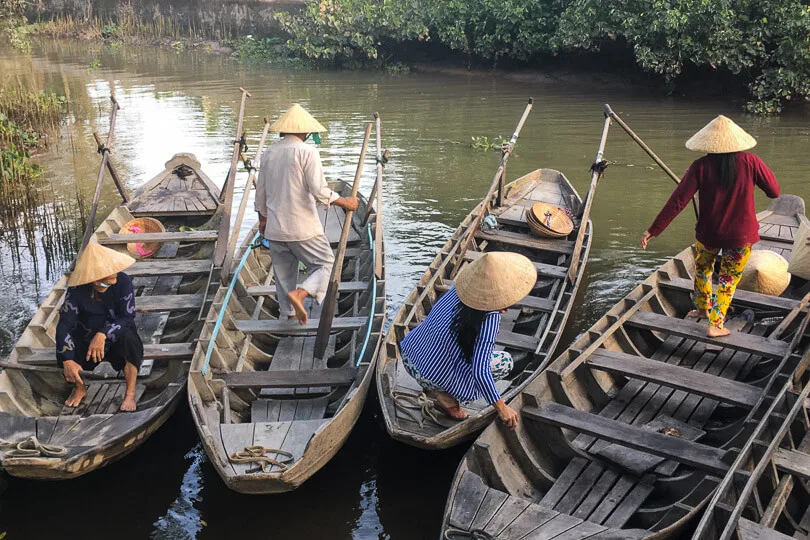
Dried and packaged specialties
Prices:
- Dried shrimp from 10k VND per 100 grams
- Dried fruit from 15k VND per 100 grams
- Dried squid from 60k VND per 100 grams
Fragrant teas, sweet jams, chilli pastes – you name it. If you love Vietnamese cuisine, buy some of their essentials so you can recreate your favourite dishes at home.
Dried shrimp adds a great flavour to your cooking and is a fundamental ingredient in many Southeast Asian dishes. Many countries may not allow you to bring these back with you, so research your custom’s policies beforehand.
Dried mango is incredibly expensive in our home country so we made the most of the opportunities during the trip. We’d always have dried mango handy as snacks. You’ll find many stores with dried fruit at Ben Thanh Market.
Embroidery
Price: Depending on the item, 40k+ VND. Prepare to pay more for a large piece i.e. wall hanging.
My favourite item to buy which is also very practical is a purse. The embroidered wall hangings are also very beautiful and can be rolled up so they take up very little luggage space.
We also picked up a patchwork animal doorstop. Probably not the best idea as it was quite bulky and an awkward shape to pack, but it was so cute I could not resist.
You’ll also find square pillowcases, table cloths and table runners.
This is another example of an item that varies in quality depending on where it is bought. Markets usually have good, cheap alternatives. If you’re looking for a high-quality, hand-stitched piece, it may pay to visit a speciality store instead.
Jewellery
Price: 30k+ VND.
Jewellery in Ben Thanh Market is super cheap especially woven and beaded bracelets. Save space in your suitcases and come without any jewellery, then buy some when you arrive.
If you have sensitive ears and are allergic to certain metals, avoid buying earrings. There are a number of stalls selling watches in Ben Thanh Market, as well as necklaces and rings, so there are plenty of alternatives.
Jewellery takes up virtually no space in your suitcase so they’re great for souvenirs and gifts. Buy more than one and try to bargain for a great deal. All the jewellery I bought on my trip cost me between 30-50k VND per piece.
Coconut candy
Price: 30-60k VND for a bag.
Originating in the small Ben Tre Province in the Mekong Delta, coconut candy has now become a well-known treat in Vietnam.
The toffee-like consistency is wrapped in an edible layer of rice paper. Try out all the flavours on offer although we agree you can’t beat the original.
This makes for a great gift to bring home that is super cheap and takes up little space in your luggage.
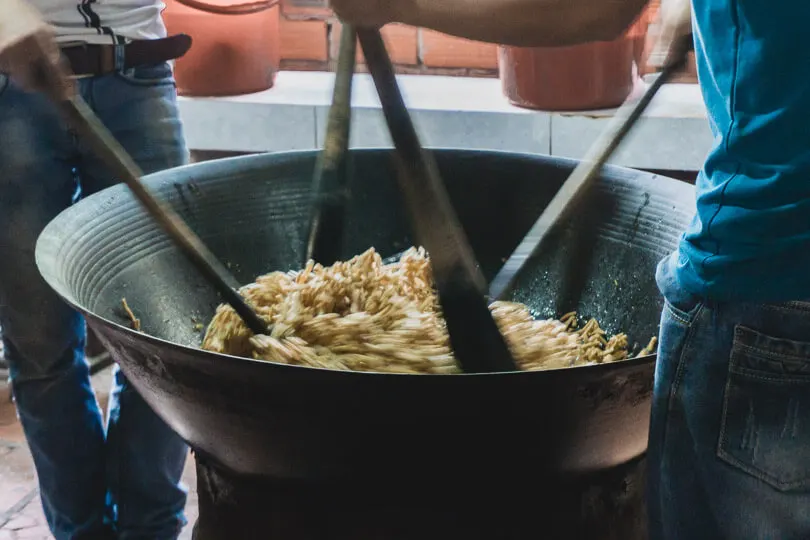
Fresh fruit
Price:
- Pineapple: 5k VND
- Banana: 2k VND
- Lychees and mangoes: 30k VND per kg
You’ll find tropical fruit stalls are around every turn in Vietnam. They have plenty within Ben Thanh market which makes for a refreshing, healthy treat in the hot weather.
It is highly recommended to buy fruit with a peel i.e. bananas. Some fruit may have been washed in contaminated water containing certain pathogens which could make you seriously ill.
You’ll also see many stalls where the vendors have already peeled the fruit; the most common being pineapple. Avoid buying these – you cannot be sure how long the fruit has been sitting out and how it was washed.
Rambutans are a great tropical fruit to try as well as lychees and dragonfruit. If you’re feeling adventurous, give durian a try. It’s definitely an acquired taste and not for us!
Ben Thanh Market Food
We’ve given food a separate section as there are so many choices you must try!
After spending an hour or two shopping, you’ll probably have worked up an appetite. Ben Thanh Market has its own food court which is between the level of street food and cafe food.
These are our five favourite dishes to try here. The prices we’ve given you are indicative of Ben Thanh prices. Typically, the prices for market food are about half what you would expect to pay at a restaurant.
For some of the best meals in Vietnam, make sure you check out our list of the 10 best restaurants in Ho Chi Minh City. These are all found near Ben Thanh Market in District 1.
Goi cuon (fresh spring rolls)
Price: 40k VND for four
If you’re looking for a fresh snack, look no further!
These are definitely my favourite Vietnamese dish and my (almost) everyday go-to. The most common fillings include pork and prawn along with lettuce and vermicelli noodles, although vegetarian and pescatarian options are often available.
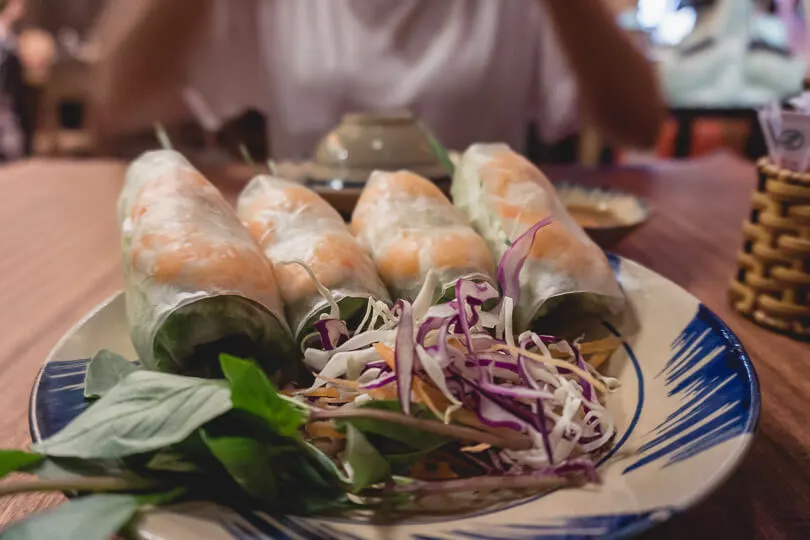
Cha gio (deep-fried spring rolls)
Price: 40k VND for four
These deep-fried pockets of joy are also a great choice for a snack. Pork is the most common flavour and is our favourite, so be sure to give it a try.
Bun rieu cua (crab noodle soup)
Price: 40-60k VND
If you’re looking for an alternative to pho bo and you’re a fan with seafood, order bun rieu cua. It’s a crab-based dish. Noodles are served soaked in a tomato and crab broth. Tomato isn’t commonly served in Vietnamese dishes so I find this one very interesting.
There are plenty of stalls within Ben Thanh Food Court to buy bun rieu.
Che ba mau (three-coloured dessert)
Price: 20k VND
This is the most common dessert in Vietnam. Most of the time, you’ll get the option to customise your dessert – just point out to the vendor what you’d like.
The dish starts with a coconut milk base. A popular combination is red bean, yellow mung bean paste and green pandan jelly, hence the name. These are all flavours characteristic of Southeast Asia.
Sinh to xoai (mango smoothie)
Price: 25k VND
Another refreshing treat made from locally-sourced tropical fruits. If there isn’t a Vietnamese iced coffee in our hands, it is always a mango smoothie.
Some places also do a dragon fruit smoothie – these are amazing and definitely worth a try too.


Please , i have been to the market over 6 times since 16 years ago . I want to buy the emborydied shoe bags please , plus polo shirts xxxl in all colours . Just one market i will deal with thanks
I have thoroughly enjoyed reading your article! wonderfully written! Thank you! Full of useful information and for someone who has not been to Vietnam and dont know where to start, this gives me confidence to do solo travel. Im asian living in Sweden?? and have always wanted to visit Vietnam. Your post helped a lot to give me the courage to go ahead and plan the trip when the situation gets better and it is ok to travel again. Will definitely reread the blog in the future. More power and very best wishes to you…..